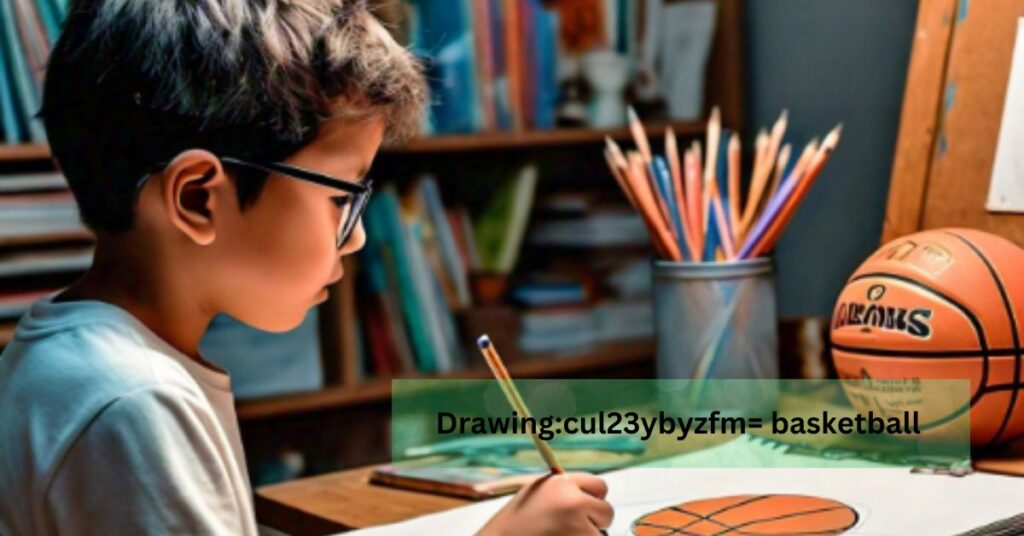Drawing basketball scenes, especially using the “drawing= basketball” method is a fascinating blend of artistic creativity and sports dynamics.
This approach combines traditional drawing techniques with modern digital methods to create vivid, dynamic illustrations of basketball players, equipment, and environments.
Whether you are sketching a slam dunk, a fast-paced dribble, or an intense defensive play, mastering basketball drawings requires attention to anatomy, movement, and perspective.
Understanding the Basics of Drawing Basketball
Before diving into the specifics of drawing basketball scenes, it’s essential to grasp some basic drawing concepts, such as perspective, proportions, and shading. These foundational skills will allow you to convey the action and details of a basketball scene better.
Basketball scenes are dynamic, with players jumping, running, and shooting. Understanding perspective allows you to position players and objects (like the hoop) at different angles, giving your drawing depth and realism.
Basketball players come in all shapes and sizes, but the human form follows specific proportions. Understanding these proportions helps in drawing anatomically correct figures, whether they’re dribbling, jumping, or shooting.
Basketball is often played in well-lit indoor arenas or under sunlight. Mastering shading and lighting will give your drawings a realistic touch, emphasizing muscle tone, the basketball’s curvature, and the court’s details.
Tools and Materials Needed
To start drawing, you’ll need basic art supplies. Although professional tools can help, even beginners can achieve great results with simple materials. Here’s a list of recommended tools:
- Pencils: Start with graphite pencils from hard (H) to soft (B). Hard pencils are great for light sketches and outlines, while softer pencils are ideal for shading and depth.
- Paper: Use sketching paper with a fine texture. Heavier paper works better for more detailed work and shading.
- Erasers: A good-quality eraser is essential for correcting mistakes and creating highlights.
- Ruler and Compass: These tools will help you accurately draw the basketball court and the round shape of the ball.
- Colored Pencils or Markers (Optional): If you want to add color to your drawing, use colored pencils or markers for a vibrant finish.
Drawing the Basketball Itself
Starting With The Outline
To draw a basketball, start by sketching a circle to form the basic shape. Use light strokes initially so you can make adjustments. After getting the perfect circle, divide it with curved lines that mimic the pattern on a real basketball. Typically, there are eight panels on the ball, which intersect to form the familiar shape.
Adding Texture And Shading
Once you have the basic outline, adding texture can make it more realistic. Basketballs have a pebbled surface, so lightly dotting the ball with small, uniform marks can simulate this texture. Finally, shading is essential to create a sense of depth. Identify where the light hits the ball and shade the opposite side to show the curvature, using softer pencils for the darker areas.
Drawing a Basketball Player
Drawing a basketball player into action is one of the most exciting challenges. Here’s how to break it down:
Step 1: Proportions of the Body:
Start with the basic human figure. A basketball player’s body is often athletic and muscular, so pay close attention to proportions. The head should be smaller than the torso, and the legs should be longer than the torso.
Step 2: Action Poses:
Basketball players are rarely standing still. Sketch action poses like running, jumping, or shooting to capture movement. Use quick, light strokes to get the basic outline of the action before adding details.
Step 3: Details
Once you’re satisfied with the basic outline, add details like the facial features, jersey, shorts, and shoes. Ensure to include the player’s muscles, as basketball requires strength and agility. Shading around the muscles will add depth and make the figure more realistic.
Step 4: Clothing and Accessories
Basketball uniforms are relatively simple, but adding wrinkles and folds in the jersey and shorts can make your drawing lifelike. Pay attention to accessories like wristbands, headbands, or sneakers, as these small details add character.
Drawing the Basketball Court
The court plays a crucial role in setting the scene. While it might seem like a flat surface, perspective will help you create depth in your drawing.
- The Layout: Start by sketching the basic outline of the basketball court, including the three-point line, free-throw line, and basketball hoop.
- Perspective: Use vanishing points to draw the court from a certain angle, whether above or at the player-eye level. This will give the scene depth, making the court appear to stretch into the distance.
- Details: Add court markings, the texture of the floor, and the hoop with its net. Shading can show the lights’ reflection on the polished court surface.
Conveying Motion in Basketball Drawings
Using Dynamic Poses
One of the most exciting challenges in drawing basketball is capturing motion. Basketball is a fast-paced sport, and your drawing should reflect this. Start using dynamic poses—players mid-shot, running, or leaping toward the basket. Quick, flowing lines help convey speed and movement.
Blurring for Effect
You can also add blur effects to certain parts of the drawing, like the basketball or a player’s arms and legs, to show fast motion. Light shading around these areas can further enhance the sense of speed.
Background and Crowd Details
Creating a Lively Arena
While the focus of your drawing may be on the players and the court, adding background elements like a crowd or a scoreboard can give context to your scene. When drawing a crowd, you don’t need to focus on every person; instead, suggest the mass of spectators by drawing heads and hands raised in excitement. This gives the impression of a large audience without overwhelming your drawing with detail.
Including Realistic Game Elements
Banners, advertisements, or scoreboards can make the setting feel more authentic, especially in a game scenario. Small details like this can elevate your drawing from a simple sketch to a complete scene.
Color and Final Touches
Adding Color to Uniforms and Court
While a black-and-white drawing can be effective, adding color will make your basketball scene pop. You can start by coloring the uniforms in the team’s colors. Use bold, vibrant colors for jerseys, shorts, and shoes, and match them with a team’s official colors if you’re drawing a real game.
Shading and Highlights for Realism
The basketball should also have its distinctive orange-brown hue, and you can use different shades to show lighting effects. For the court, you might want to use wood tones, especially for indoor scenes, or cooler tones for outdoor courts.
Shading and highlights will help bring everything together. Adding darker tones where shadows fall, such as under players’ feet or on the ball where it faces away from the light, adds a realistic touch. Don’t forget to highlight where light hits the ball or the players, giving your drawing a three-dimensional feel.
Challenges You Might Encounter
While drawing basketball can be incredibly rewarding, it also comes with challenges:
- Proportions: It can be tough to get player proportions right, especially when they’re in motion. Always refer back to basic human anatomy and use reference photos if necessary.
- Capturing Motion: It can be difficult to convey speed and fluid movement in a still image. Practice sketching quick action poses before attempting detailed work.
- Details vs. Simplicity: Striking the right balance between adding detail and keeping the drawing clean can be tricky. Too many details can clutter the scene, while too few can make it look unfinished.
Practice Makes Perfect
Like any art form, practice is essential. Start with basic sketches of the basketball and simple poses before advancing to more complex scenes with multiple players and detailed backgrounds. Over time, you’ll develop the ability to draw basketball scenes with greater accuracy and fluidity.
Frequently Asked Questions:
How Do I Add Emotion To The Faces Of Basketball Players In A Drawing?
Focus on the eyes, mouth, and body language to convey emotions like determination, joy, or frustration. Exaggerate facial expressions slightly to make them stand out in a dynamic scene.
Can I Use Digital Tools To Draw Basketball Scenes?
Yes, digital drawing software like Procreate, Adobe Photoshop, or Krita can be great for basketball scenes. They offer various layers, shading, and coloring tools that simplify the drawing process.
How Can I Improve My Basketball Drawing Skills Quickly?
Practice regularly using reference photos of basketball players and scenes. Focus on different elements each time, such as motion, anatomy, or lighting, to gradually enhance your overall skills.
Should I Use References When Drawing Basketball Scenes?
Absolutely! References from real games or photos can help you better understand poses, perspectives, and details that might be difficult to visualize from memory.
How Do I Draw The Basketball Net?
Sketch the net with intersecting diagonal lines hanging from the hoop. Vary line thickness to show depth, and use shading to indicate folds and light reflection.
What’s The Hardest Part Of Drawing A Basketball Scene?
Many find capturing motion and anatomy the most challenging, especially when players are in action. Regular practice and studying reference images will help overcome these hurdles.
How Do I Draw The Reflection Of Light On A Basketball Court?
Use light horizontal strokes and soft shading to create the appearance of reflection, particularly around areas where the light source is strongest, such as directly under stadium lights.
Conclusion
Drawing basketball scenes offers an incredible way to capture the sport’s energy, athleticism, and excitement. By mastering basic drawing techniques like perspective, shading, and proportion, as well as practicing dynamic poses and action scenes, you can create compelling basketball drawings. Whether you’re a beginner or an experienced artist, every stroke brings you closer to capturing the heart of the game on paper.
Read more:


